#Tenement Museum
Text
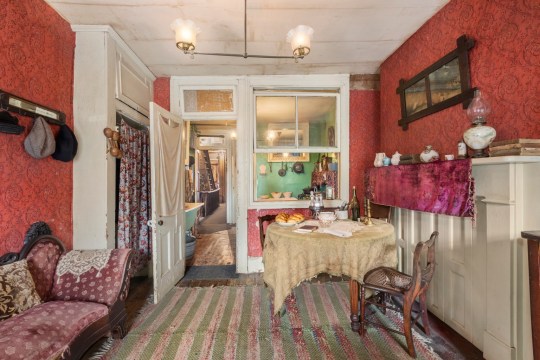
The parlor, or living room, of the Rogarshevsky family, who immigrated to New York from Russia in 1901
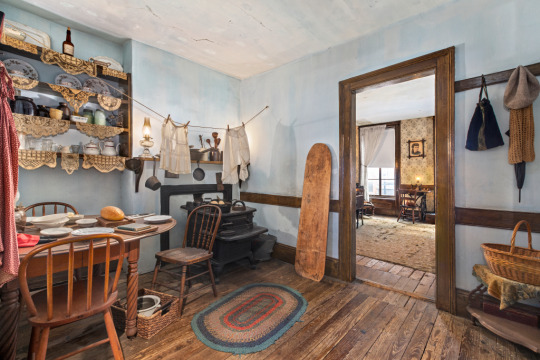
The kitchen of the Gumpertzes, a German-American family that came to New York in the 1870s
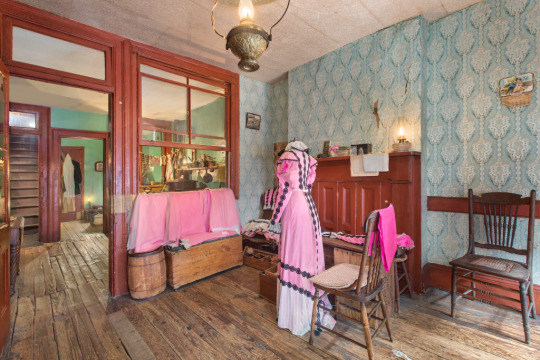
Harris and Jennie Levine ran a garment shop in their tenement apartment at the height of the Jewish Lower East Side.
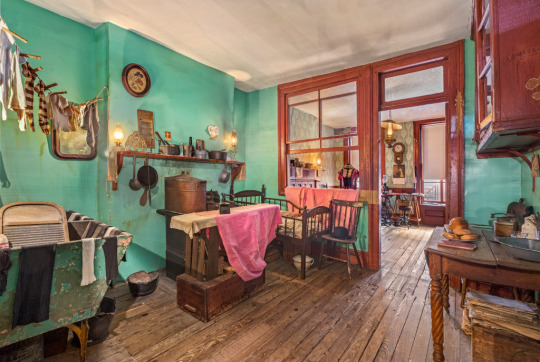
The Levine family’s kitchen

A view of the 97 Orchard staircase
Founded in 1988 by historian Ruth Abram and social activist Anita Jacobson, the Lower East Side Tenement Museum explores the uniquely American story of immigration and the rich, diverse landscape it continues to create. The Museum took root when Abram and Jacobson discovered 97 Orchard Street — a dilapidated tenement building that had been shuttered for more than 50 years.
245 notes
·
View notes
Text
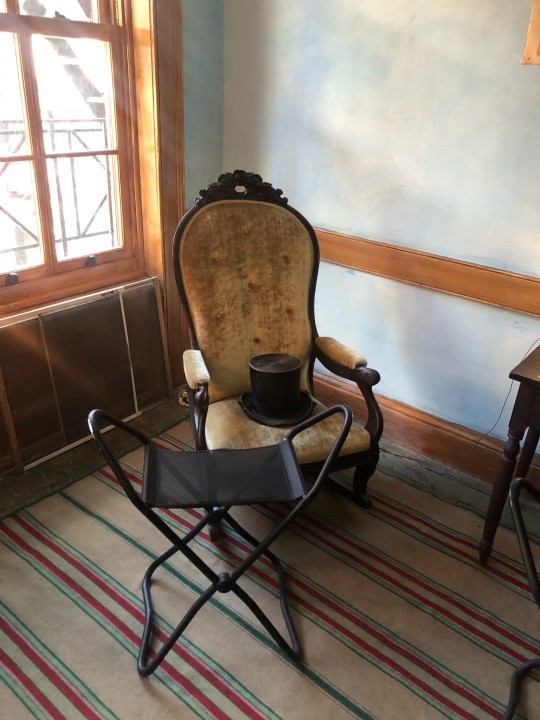

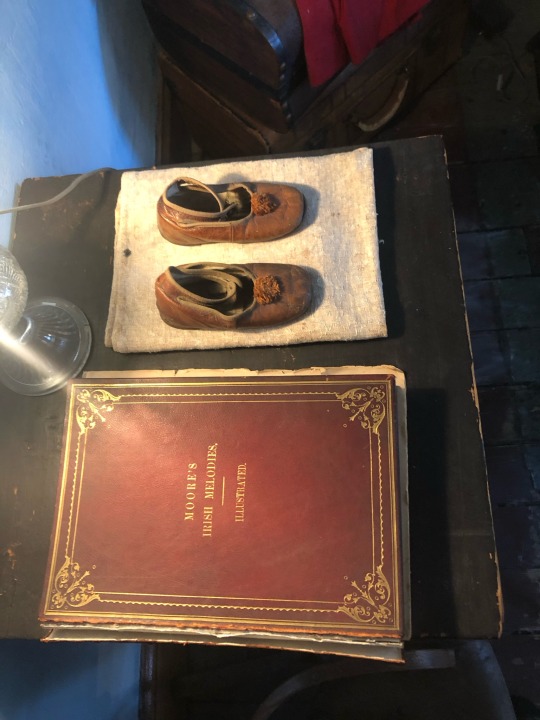
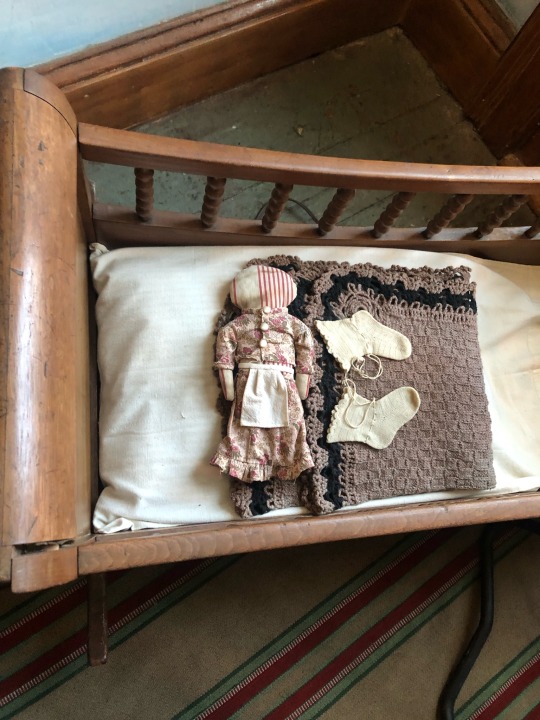
Tenement Museum, New York City
#tenement museum#nyc#photography#this was their Irish immigration tour#immigration history#nyc history#Irish American history#feels ages ago that I did this tour but this was only Sunday
2 notes
·
View notes
Text
Exploring the NYC Lower East Side
Great way to explore New York City's Lower East Side!
There are many choices for spending a day in the Big Apple. Yet I recommend spending a day exploring the NYC Lower East Side.
The NYC Lower East Side is on the southeastern side of Manhattan Island. It is roughly south of E. Houston St. and between Bowery and the East River.
NYC’s Lower East Side has a rich past. Many immigrants from the late 1800s and early 1900s found homes in this corner of…

View On WordPress
#10002#Basicilica of St. Patrick&039;s Old Cathedral#Benito One#Katz&039;s#Lower East Side#Museum at Eldridge#New York#NYC#Russ & Daughters#Tenement Museum
0 notes
Text
something i’ve noticed is that whenever a writer wants to make a tenement (historical apartment with poor conditions, overcrowding) look bad, they always take a photo of the back of the building. this has become even more obvious to me now that i live somewhere with a lot of old-ish (late 19th century to early 20th century) apartment buildings

this is building is definitely falling apart, but if you fixed up the roof, the foundation, and cleaned up and paved the road, it would look like any alley in chicago
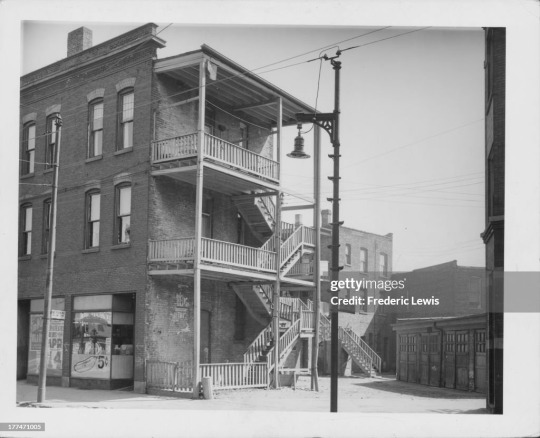
this one is especially funny because it was labeled as “a tenement block in the low income area of South Side” but honestly, it looks pretty good to me? it’s not the prettiest side of the building (again, this is the alley) but i see apartments like this every day. i live in one that resembles it.
i get that a lot of tenements had terrible conditions, but i feel like they get unfairly judged as a whole? if the building is well maintained and follows habitable guidelines, what’s the problem?
#i wish the tenement museum in nyc had more about the architecture of the tenement#it’s not a bad museum but it’s more of an immigrant experience museum rather than a tenement museum#only went on one tour though so i’d like to go back#t
7 notes
·
View notes
Text
I was meeting a client at a famous museum’s lounge for lunch (fancy, I know) and had an hour to kill afterwards so I joined the first random docent tour I could find. The woman who took us around was a great-grandmother from the Bronx “back when that was nothing to brag about” and she was doing a talk on alternative mediums within art.
What I thought that meant: telling us about unique sculpture materials and paint mixtures.
What that actually meant: an 84yo woman gingerly holding a beautifully beaded and embroidered dress (apparently from Ukraine and at least 200 years old) and, with tears in her eyes, showing how each individual thread was spun by hand and weaved into place on a cottage floor loom, with bright blue silk embroidery thread and hand-blown beads intricately piercing the work of other labor for days upon days, as the labor of a dozen talented people came together to make something so beautiful for a village girl’s wedding day.
What it also meant: in 1948, a young girl lived in a cramped tenement-like third floor apartment in Manhattan, with a father who had just joined them after not having been allowed to escape through Poland with his pregnant wife nine years earlier. She sits in her father’s lap and watches with wide, quiet eyes as her mother’s deft hands fly across fabric with bright blue silk thread (echoing hands from over a century years earlier). Thread that her mother had salvaged from white embroidery scraps at the tailor’s shop where she worked and spent the last few days carefully dying in the kitchen sink and drying on the roof.
The dress is in the traditional Hungarian fashion and is folded across her mother’s lap: her mother doesn’t had a pattern, but she doesn’t need one to make her daughter’s dress for the fifth grade dance. The dress would end up differing significantly from the pure white, petticoated first communion dresses worn by her daughter’s majority-Catholic classmates, but the young girl would love it all the more for its uniqueness and bright blue thread.
And now, that same young girl (and maybe also the villager from 19th century Ukraine) stands in front of us, trying not to clutch the old fabric too hard as her voice shakes with the emotion of all the love and humanity that is poured into the labor of art. The village girl and the girl in the Bronx were very different people: different centuries, different religions, different ages, and different continents. But the love in the stitches and beads on their dresses was the same. And she tells us that when we look at the labor of art, we don’t just see the work to create that piece - we see the labor of our own creations and the creations of others for us, and the value in something so seemingly frivolous.
But, maybe more importantly, she says that we only admire this piece in a museum because it happened to survive the love of the wearer and those who owned it afterwards, but there have been quite literally billions of small, quiet works of art in billions of small, quiet homes all over the world, for millennia. That your grandmother’s quilt is used as a picnic blanket just as Van Gogh’s works hung in his poor friends’ hallways. That your father’s hand-painted model plane sets are displayed in your parents’ livingroom as Grecian vases are displayed in museums. That your older sister’s engineering drawings in a steady, fine-lined hand are akin to Da Vinci’s scribbles of flying machines.
I don’t think there’s any dramatic conclusions to be drawn from these thoughts - they’ve been echoed by thousands of other people across the centuries. However, if you ever feel bad for spending all of your time sewing, knitting, drawing, building lego sets, or whatever else - especially if you feel like you have to somehow monetize or show off your work online to justify your labor - please know that there’s an 84yo museum docent in the Bronx who would cry simply at the thought of you spending so much effort to quietly create something that’s beautiful to you.
#shut up e#long post#Saturday thoughts#this has been in my drafts for a week haha#also this is the heart of why AI art feels so wrong#forget the discussion of copyright and theft etc - even if models were only trained on public domain they would still feel very wrong#because they’re not art. art is the labor of creation#even commercial art and art commissioned by the popes and kings of history: there is humanity in the labor of it#unrelated: I did not know living in the Bronx was now something to brag about. How the fuck do y’all New Yorkers afford this city???
26K notes
·
View notes
Text

Vibrating with excitement about answering this question in my notes I’m going to have to keep myself from writing paragraphs and paragraphs holy
#INDUSTRIAL REVOLUTION IMMIGRANT TENEMENTS!!!#<- I dont fucking know why I’m so interested but I am I want to know everything I went to a tenement museum
1 note
·
View note
Text
some smaller bookstores, presses, and museum shops to browse and know about! Most support smaller presses, diverse authors and authors in translation, or fund museums and arts research)
(disclaimer: the only three I’ve personally used are the Yiddish book center, native books, and izzun books! Reccomend all three. Also roughly *U.S. centric & anglophone if people have others from around the world please feel free to add on
birchbark books - Louise Erdrich’s book shop, many indigenous and First Nations books of a wide variety of genres including children’s books, literature, nonfiction, sustainability and foodways, language revitalization, Great Lakes area focus (https://birchbarkbooks.com/)
American Swedish institute museum store - range of Scandinavian and Scandinavian-American/midwestern literature, including modern literature in translation, historical documents, knitters guides, cookbooks, children’s books
https://shop.asimn.org/collections/books-1
Native books - Hawai’i based bookstore with a focus on native Hawaiian literature, scholarly works about Hawai’i, the pacific, and decolonial theory, ‘ōlelo Hawai’i, and children’s books Collections | Native Books (nativebookshawaii.org)
the Yiddish book center - sales arm of the national Yiddish book center, books on Yiddish learning, books translated from Yiddish, as well as broader selection of books on Jewish history, literature, culture, and coooking https://shop.yiddishbookcenter.org/
ayin press - independent press with a small but growing selection of modern judaica https://shop.ayinpress.org/collections/all?_gl=1kkj2oo_gaMTk4NDI3Mzc1Mi4xNzE1Mzk5ODk3_ga_VSERRBBT6X*MTcxNTM5OTg5Ny4xLjEuMTcxNTM5OTk0NC4wLjAuMA..
Izzun books - printers of modern progressive AND masorti/trad-egal leaning siddurim including a gorgeous egalitarian Sephardic siddur with full Hebrew, English translation, and transliteration
tenement center museum -https://shop.tenement.org/product-category/books/page/11/ range of books on a dizzying range of subjects mostly united by New York City, including the history literature cookbooks and cultures of Black, Jewish, Italian, Puerto Rican, First Nations, and Irish communities
restless books - nonprofit, independent small press focused on books on translation, inter and multicultural exchange, and books by immigrant writers from around the world. Particularly excellent range of translated Latin American literature https://restlessbooks.org/
olniansky press - modern Yiddish language press based in Sweden, translators and publishers esp of modern Yiddish children’s literature https://www.etsy.com/shop/OlnianskyBooks
https://yiddishchildrensbooks.com/ - kinder lokshen, Yiddish children’s books (not so many at the moment but a very cute one about a puffin from faroese!)
inhabit books - Inuit-owned publishing company in Nunavut with an “aim to preserve and promote the stories, knowledge, and talent of Inuit and Northern Canada.” Particularly gorgeous range of children’s books, many available in Inuktitut, English, French, or bilingual editions
https://inhabitbooks.com/collections/inhabit-media-books-1
rust belt books - for your Midwest and rust belt bookish needs! Leaning towards academic and progressive political tomes but there are some cookbooks devoted to the art of the Midwest cookie table as well https://beltpublishing.com/
#Books#shopping reccomendations#Targeted/smaller and more specific presses can be jsut as dangerous even more so as you find so many things you didn’t know you needed!#(But you do! You so very much d)#Esp if you’re feeling like something beyond target book club picks lol
170 notes
·
View notes
Text
Deal Announcement: WHEN THE TIDES HELD THE MOON (Erewhon, Spring 2025)
If you've been with me on Tumblr for a while, then you may already be familiar with this title and been waiting for this particular update, and all I can say is thank you endlessly for patiently sticking it out with me! I am so incredibly pleased to announce that WHEN THE TIDES HELD THE MOON has been acquired by Diana Pho at Erewhon Books/Kensington Publishing as an illustrated adult historical fantasy!

Tor.com has published a blush-inducing article which features some insights from me about what inspired the story, reactions from Hugo Award-winning editor Diana Pho on what drew her to the book, a downright tear-jerking endorsement from the incomparable TJ Klune, and my original concept art of Benny & Río. I hope you'll take a moment to read it at the link below!
This project is the culmination of a lifelong dream to write and illustrate my own books, and there are no words to convey the depth of my gratitude to Diana for the gift of seeing it be delivered as an illustrated adult work. Infinite thanks must also go to my unstoppable agent Saritza Hernandez, my phenomenal critique partners Anna Racine and Mark Duplane, and the many experts who generously and enthusiastically donated their time and resources in the middle of lockdown to help me bring 1911 Brooklyn, NY to life, including:
Virginia Sanchez-Korrol –– Professor Emeritus of Puerto Rican & Latino Studies, CUNY Brooklyn College
David Sharp -- President, The Waterfront Museum
Jamie Salen, David Favaloro, & Lana Rubin –– Marketing Director, Director of Curatorial Affairs, & Collections Manager (respectively), The Tenement Museum
Adam Realman -- Artistic Director, The Coney Island Circus Sideshow
More details about WTTHTM's release will be forthcoming, but in the meantime, thank you all again for believing in this story and supporting it when it was just a humble MerMay fic. I can't wait until you meet Benny and his beloved Río in print in 2025!
#wtthtm#benny and rio#brio!#when the tides held the moon#deal announcement#tj klune#erewhon books#kensington books
301 notes
·
View notes
Text

A back alley in a row of tenements, 1937.
Photo: Max Yavno via the Museum of Contemporary Art
174 notes
·
View notes
Text
The House MD characters need more Life-changing Field Trips. I tried to do a poll but

Kutner & Thirteen. Comicon like @greghatecrimes headcanon. Ooh or a road trip down to Roswell.
Chase & ??? after his major injury & dealing with depression and healing. Extended road trip. (Kutner would’ve been the obvious choice but). I think it should be family vibes so Thirteen I guess.
Chase & Thirteen. European backpacking maybe? They keep going in cathedrals even though they should really stop doing that.
The whole team ends up at a Renaissance Fair. But I’m not sure who the non-nerd is (there’s only one and it isn’t Taub). Maybe Wilson? I think Park would be embarrassed but love it anyways.
Kutner & Taub go to a cheesy pop-up carnival as per my headcanon.
Thirteen, Kutner, and Taub go to a special haunted house down the coast. House and Wilson show up to scare the crap out of them at the end. Foreman, Cameron and Chase get lost on the way and end up at a roadside cafe instead.
Thirteen & Cameron. Rocky cliff beach trip? Six flags trip? Wine tasting tour? Whale watching? Something scenic somehow I think. Which ofc devolves into something way more wild
Kutner & Cuddy & Rachel. Some sufficiently child-oriented trip.
Wilson, House and Alvie? Some contestant based show that House and Alvie trick Wilson into?? Best of Route 66? There is no way this doesn’t end the same way as the bachelor party.
Wilson and the OG trio. To a conference together but their return flights get canceled.
Wilson & Cuddy. NYC to see Broadway shows and art. End up at the Lower East Side Tenement Museum.
Wilson & Thirteen. Supposedly to do something fancy but actually to do something fun and ridiculous but without House lol
And finally J Whitner and House should go on an Accessibility Tour where they see if businesses that claim to be accessible really are. And no one can tell if they’re in cahoots or if they’re feuding (both ofc)
#I’m never gonna have time to write this all lol#but I love trips#I love life changing field trips#birthmarks was my favorite canon one#no wait House Thirteen and the great potato war#something like that#house md#gregory house#james wilson#lisa cuddy#lawrence kutner#greg house#hate crimes md#hatecrimes md#robert chase#eric foreman#allison cameron#chi park#alvie#dr remy hadley#remy thirteen hadley#chris taub#j whitner#heacanons#lifechanging field trips
97 notes
·
View notes
Text
Sunday Steve - Day 13.5: What Did a Tenement Look Like?
As a follow up to my tenement building post, I've done my best to find a collection of photos to show what apartments Steve lived in could have looked like. As I mentioned in my earlier Sunday Steve post, a lot of tenement pictures were taken specifically because of the poor conditions, so I tried to find pictures that would show a side of tenements we might not usually see.

Tenement playground, circa 1900-1937 (Link)
Contemporary photos

Interior stairwell, 1937. (Link)
Look at the wallpaper! Also I can just imagine children playing in that nook there, using it like a fort or something.

Interior between 1900 and 1910. (Link)
Look at all the pictures on the walls, the patterned and no doubt colourful table cloth and the decorative elements of the stove! This apartment looks like it has a gas stove and lights.
(part of me does wonder if this photo was staged to some extent, perhaps to advertise the new laws going in (?), but that's only a theory.)
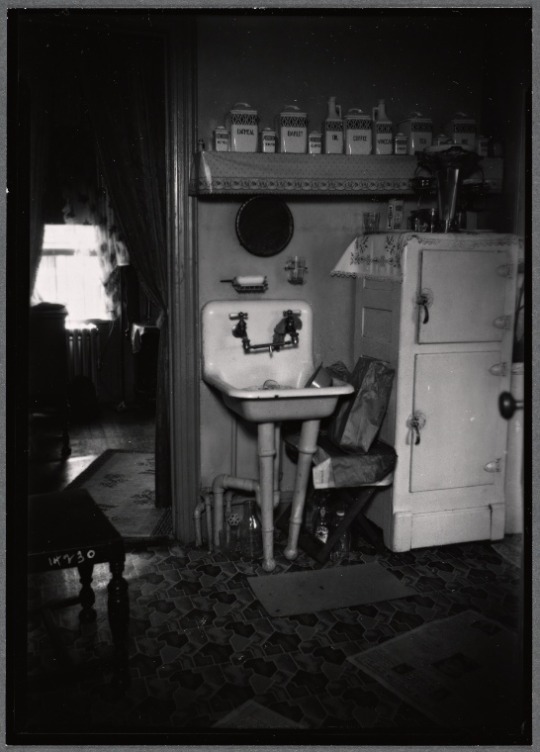
Kitchen interior with sink and icebox, 1935. (Link)
You can see the draped curtains, the mirror above the sink and the cloth on top of the fridge. The shelf with all the jars has been recovered with a decorative trim and the floor is patterned linoleum.

Family at kitchen table in a dumb-bell tenement, circa 1935. Note the angled kitchen window by the stove looking into an air shaft. (Link)
(The Barnes family anyone?) Again, patterned, clean floors, a gas stove, what may be a folded up bed in the left-hand upper corner. Five toothbrushes above the sink, a mirror above the shelf, the trim on the shelf itself. I think the dark thing next to the boxes in the lower right-hand corner might be a toy pram.
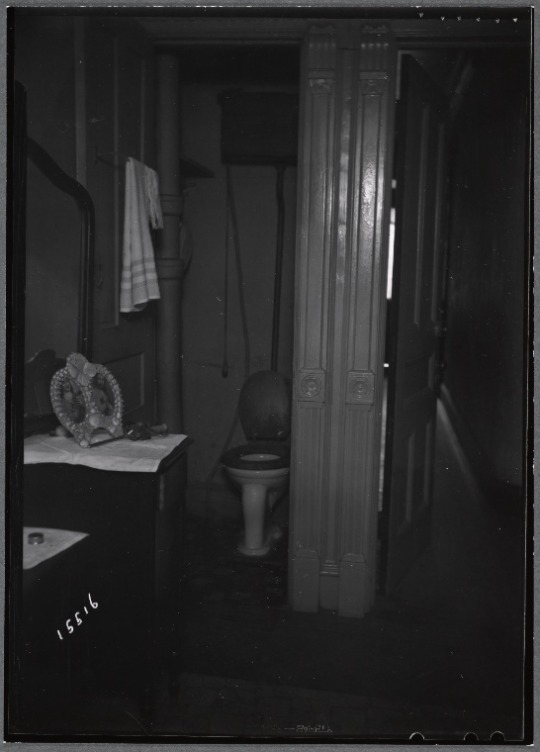
Interior view of dressing table and toilet, 1936. (Link)
Typical small toilet, probably built after the New Law required them. Note the pretty framed photo of religious figures on top of the dressing table, what I think is an electric curling iron next to it, and the sculpting details of the wall pillar.
Reconstruction
But black and white photos don't give us a full idea of what things would be like. Luckily, there is Tenement Museum in Manhattan that has 1910 and 1930 Old Law restored tenement apartments.


Outside of museum and stairs leading up. (Link)
This tenement is 5 floors, which is standard for Old Law. New Law tenements were often higher. The tenement, like many tenements, had a store front on the street level.
If you look carefully you can see the tin-plated ceilings. Note how you can see a painting on the wall across from the stairs. In the tour they discuss how these were people's homes and they decorated them and were proud of them too.




Images of a 1910 style apartment. (Link) (Link)
These tenements are 3 rooms, bedroom, kitchen and parlour. Note the bed in the kitchen where Steve could've slept. This could also be a place for a crib for a baby. These apartments have shared toilets in the halls that were for two families.
Also look at the green and red walls! So much colour! And the pictures hung on the walls! There's a rug on the floor, doilies and a cushion on the couch, a patterned curtain behind the door... I wanted to highlight the homeyness.
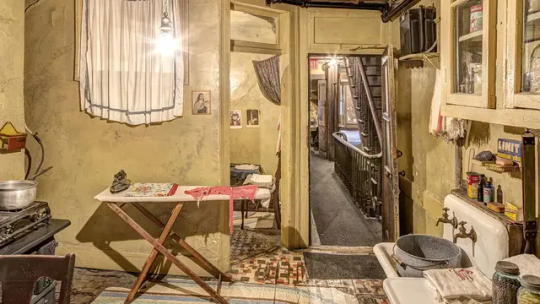

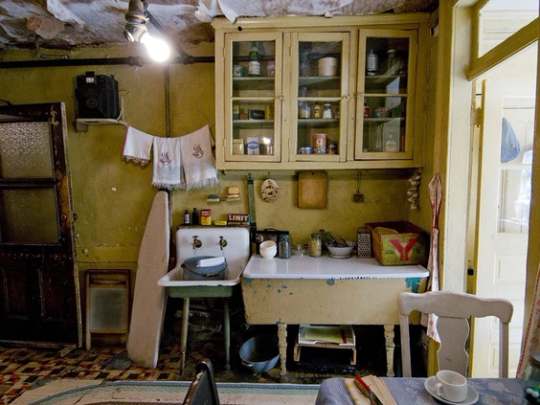
Kitchen of 1930s style apartment. (Link) (Link)
With these photos you can see the three rooms of this tenement. A small bedroom by the front door, a kitchen and a living room past it. The apartments for this building were electrified in 1924, so they have lights, and a radio and an electric fan in the living room.
The apartment had coin operated gas, which could be the black box on the wall by the front door. The gas also connects to a water heater for this apartment which can't really be seen, but it is connected to the stove.
The built in shelves by the table was custom built by the father of the family living here. Residents often painted or wallpapered their space when moving in to make it their own. According to the Tenement Museum, linoleum flooring was really common, and you can see how this apartment has linoleum designed to look like a rug.


Living room and bedroom of the same 1930 apartment. (Link) (Link)
The living room isn't very staged, I'm not sure why since I haven't taken the tour. There is a disassembled bed frame against the left wall, so it's possible a bed is usually set up in this room for the parents. Also the former resident of the apartment said it was sparsely furnished, so they may be trying to recreate that.
The ice box for this family is kept on the fire escape, which is not shown.
In the window of the living room you can see green plants. These are morning glories the father planted in re-purposed cheese boxes. According to the former resident, they got the cheese through welfare aid, and cheese always seemed to be in surplus from that program. The apartment has electricity and there is an electric fan on on the dresser with the mirror.
The second photo shows the bedroom, which is that angled room next to the front door in the kitchen. The red cloth covered thing in is a bed that was shared by two siblings and folded up and covered every day.
Look at all the colour! The patterned linoleum floors! The climbing flowers in the living room window! The radio in the nook by the kitchen table! These places were not dreary and brown just because they were old or cheap.
Recollections from the previous resident:
Rosaria [her mother] decorated the apartment by draping fabrics everywhere: lacy curtains at the windows, coverlets in the beds, skirts across the shelving that Adolfo [her father] built into the walls. The family kept birds as pets. They cultivated flowers; morning glories twined at the window. The radio played, day and night, as they laughed with Amos and Andy, hummed along with Fred Waring and his Pennsylvanians, and followed the puzzling, upper-middle-class lives of One Man's Family. (Link)
Also, when the previous resident came back to see the tenement museum of her childhood apartment, she noted that the place was messier than her mother ever kept it, so they fixed that. Tenements could be very clean and well kept, especially since cleanliness and health were something people judged.
I really wanted to show that while small and cheap, Steve’s apartments would have still been full of life and colour.

Tenement Museum hall toilet, circa 1904-1935 (Link)
I don't know what time period the museum has this toilet as, but you can see how small it was, and also that it has bright yellow walls!
This toilet has a leaflet of papers on the back wall, probably for toilet paper. As my toilet paper post discussed, toilet paper became more common with indoor plumbing due to clogged pipes and such, so I imagine this is early 1900s. I'm fairly certain Steve would be used to using toilet paper!
What's with all the indoor windows?
A lot of Old Law tenements have windows leading from one room to another. These are for airflow and light. They are also a sneaky way the landlords tried to get around the law that every room had to have a window. The New Law later required the windows to actually have access outside.
These windows are also known as tuberculosis windows. While they may have been a cop-out by landlords, they were still intended to improve airflow and light in narrow tenements which would otherwise have only one outward facing window.
I hope this overview gave you a broader understanding of what tenements could look like and some appreciation of the ways people brightened up their homes.
Many more tenement pictures found here:
This link has a lot more interior shots, but also some with homicide victims (!), so approach at your own risk.
This link has more images of the Tenement Museum, showing other bedrooms from different eras and different tenement rooms. While some are styled as late 1890s era apartments, they still reflect what rooms and life would and could have looked like.
Sunday Steve Masterpost
#sunday steve#steve rogers#tenement#tenements#tenement buildings#interiors#reconstructions#photos#photographs#early 20th century#20th century#american history#history#1900s#black and white#black and white photo#colour photography#meta#steve rogers meta
40 notes
·
View notes
Text
I have been a bit quiet of late on here...but for once, it's a good thing. I was off having the time of my life in NYC!!


I rarely feel immediately comfortable in a place in the way I did in NYC and I'm still at a loss to explain why. It just...fitted with my brain. There are too many magic things to recall - the view from 30 Rock, witnessing a total solar eclipse along with half of NYU in Washington Square Park...
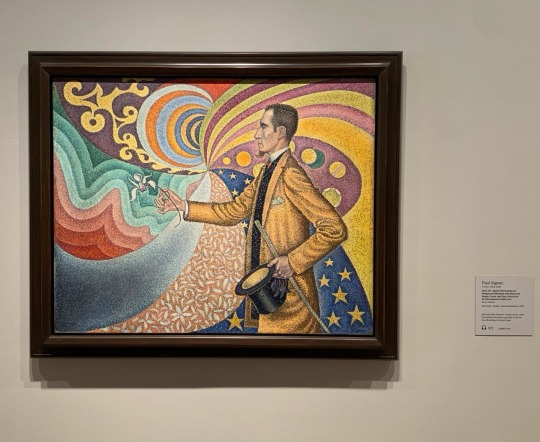
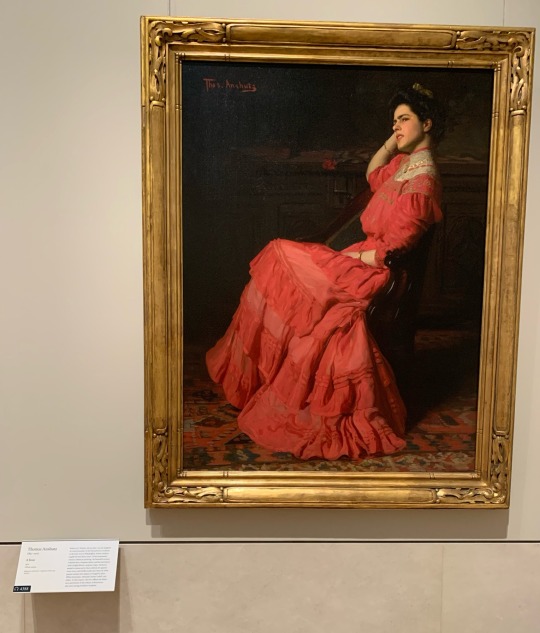
I saw artworks I never expected to see in real life (the Signac portrait of French writer Félix Fénéon at MoMA, on the left) and that chimed nicely with my vibe (the painting of the young woman on right, at the Met, called...'A Rose').
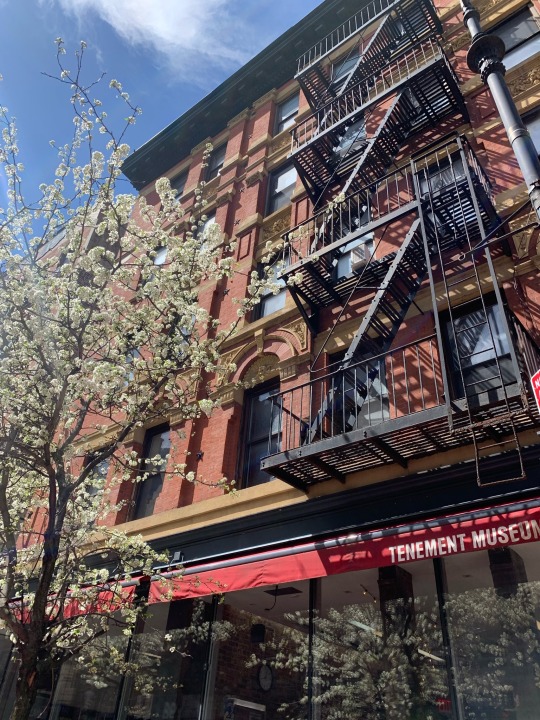

I cried at the Tenement Museum in dealing with my family history, and had one of the greatest martinis of my life at Bemelman's Bar.
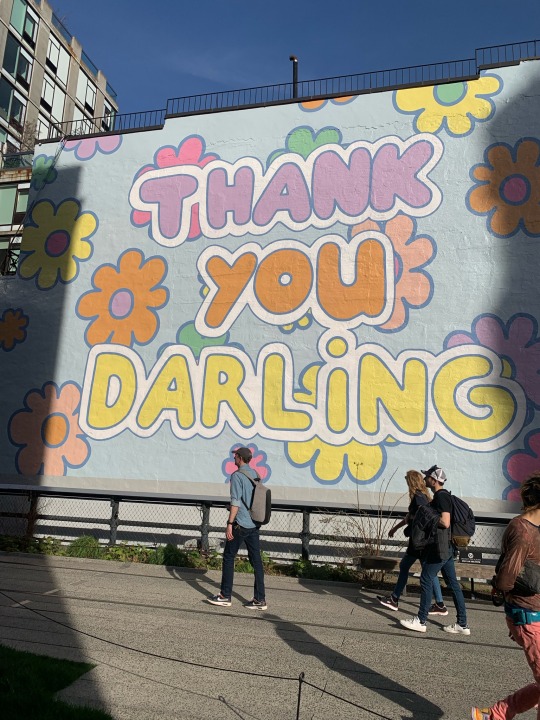
And best of all, I got to hang out with @paulmescal-s in real life, eat Spanish food, walk the High Line, blush like sluts at t-shirts featuring That Man, and answer the question "hey, are you both wearing Diego Luna t-shirts?" while buying cheesecake.

Next time I'm going back to the NYPL to work in the reading room that bears my name.
Oh, and obviously I bought these, in Economy Candy on the Lower East Side.

I miss that goddamned city so much.
#personal post#rambling rose#crying outside museums is surprisingly not normal for me#but i was very moved#had a full on fangirl moment in the met too#it was just all very much my jam#and then the food#and the subway even made me very happy#that's how much i liked it#rose does nyc
25 notes
·
View notes
Text
youtube
Watch the American Climate Leadership Awards 2024 now: https://youtu.be/bWiW4Rp8vF0?feature=shared
The American Climate Leadership Awards 2024 broadcast recording is now available on ecoAmerica's YouTube channel for viewers to be inspired by active climate leaders. Watch to find out which finalist received the $50,000 grand prize! Hosted by Vanessa Hauc and featuring Bill McKibben and Katharine Hayhoe!
#ACLA24#ACLA24Leaders#youtube#youtube video#climate leaders#climate solutions#climate action#climate and environment#climate#climate change#climate and health#climate blog#climate justice#climate news#weather and climate#environmental news#environment#environmental awareness#environment and health#environmental#environmental issues#environmental justice#environment protection#environmental health#Youtube
16K notes
·
View notes
Text
New York City Vacation (3.5 Days)
Check out this 3.5 day New York City vacation itinerary.
This spring, we took a trip to NYC. Planning a trip to the Big Apple can feel overwhelming. There are so many things to do, and we only had 3.5 days (4 nights). After much research, I narrowed down my list. I hope our New York City vacation itinerary will help you as you plan your adventure.
New York City Vacation Itinerary
Arrival Day (Tuesday)
Our flight arrived at Newark Airport around 2…

View On WordPress
#Broadway#Charging Bull#Ellis Island#Empire State Building#Hotel Edison#Katz#Lombardi&039;s#Manhattan#New York#New York City#NYC#Statue of Liberty#Subway#Tenement Museum#Times Square
1 note
·
View note
Photo
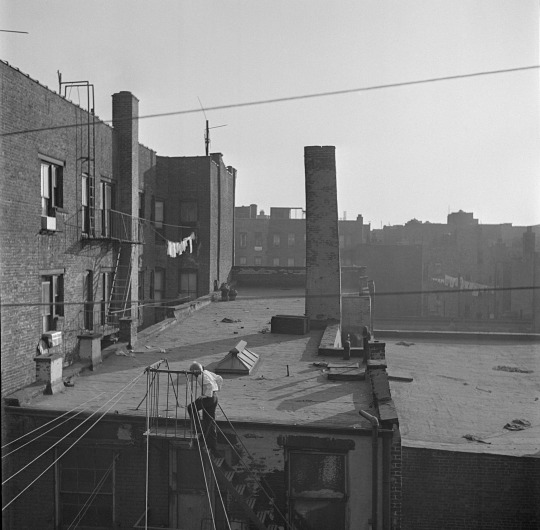
A boy climbs to a roof with the city tenements surrounding him in this 1947 Stanley Kubrick photo.Credit...SK Film Archives/Museum of the City of New York
493 notes
·
View notes
Text

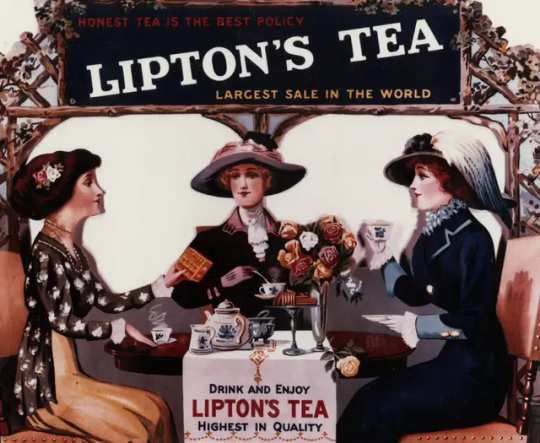

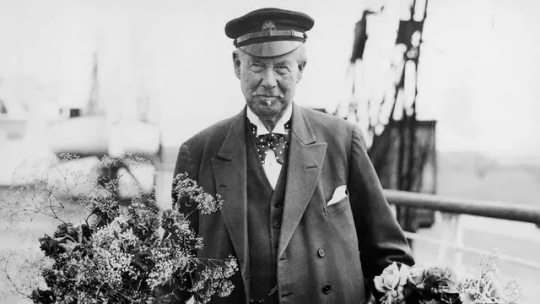

On October 2nd 1931 Sir Thomas Lipton, grocer, tea merchant died.
Say the name Lipton, and most people nowadays think of tea, although some of usthat are a certain age will recall the supermarkets. But behind that brand lies the extraordinary story of a rags-to-riches tycoon, self-publicist, philanthropist and sportsman who was honoured as "the world's best loser".
While his father worked in a succession of poorly paid jobs, young Tommy Lipton’s siblings all died in infancy, leaving him as the family’s only son.
Tommy had to leave school aged 13, because his parents needed an extra income to make ends meet. He also attended night school at the Gorbals Youth School. In 1864, he signed up as a cabin boy on a steamer running between Glasgow and Belfast and seems to have been taken with crew-members’ stories about the United States, so in 1865, Thomas used his savings to pay for a passage to New York spending the next five years there travelling across the country.
During this time he held many different jobs, including work at a tobacco plantation in Virginia; as an accountant at a rice plantation in South Carolina; as a door-to-door salesman in New Orleans; as a farmhand in New Jersey; and as a grocery assistant in New York.
Thomas returned to Glasgow in 1870. After spending some time helping his parents at their shop, he established one of his own, Lipton’s Market, at 101 Stobcross Street in the Anderston area of the city. This proved highly successful and Lipton went on to establish a chain of shops, first in Glasgow and then across Scotland, before expanding to cover the whole of the UK over the next ten years.
Meanwhile, the demand for tea was increasing among the middle classes and in 1888, by which time Lipton had 300 stores, he set out to bypass the traditional lines of supply for tea by investing directly in tea plantations. The Lipton Tea brand he established offered good quality for low prices and proved hugely popular, expanding the market for tea to all parts of society and establishing it as the national drink of choice.
Lipton was a big fan of promotional stunts. When his first 20,000 tea chests arrived in Glasgow he put on a party, complete with a brass band and bagpipe parade. In 1893 Sir Thomas Lipton officially established the Thomas J Lipton Company, a tea packaging company based in Hoboken, New Jersey . He felt that tea should be a drink for everyone, not just the wealthy , so he strived to make packaging and shipping less expensive.
Instead of arriving in crates, Sir Thomas packaged his loose tea in multiple weight options. The tea was also standardised, so Lipton customers knew exactly what to expect.
Thomas Lipton developed a passion for yachting, between 1899 and 1930 Lipton challenged the American holders of the America’s Cup through the Royal Ulster Yacht Club five times with yachts he named Shamrock through Shamrock V. He never won the cup, but he was awarded a special trophy as “the best of all losers”. This may sound double-edged, but one effect of his efforts to win the cup was to make his name well known across the United States, and his tea very popular there.
Although Lipton, through his yachting, became a friend of royalty, as a self-made man he still had difficulty breaking into some corners of the highly stratified British society of the day. He was, for example, only accepted as a member of the Royal Yacht Squadron shortly before his death.
Lipton died at his home in north London in 1931. He left most of his wealth to his native city of Glasgow. His yachting trophies are now on display at the Kelvingrove Art Gallery and Museum. Sir Thomas Lipton was buried alongside his parents and siblings in Glasgow’s Southern Necropolis.
Liptons continues today as part of the multinational Unilever brands, their teas and other beverages still bear his name and are a world known brand, not bad for a young lad born in a Glasgow Tenement to Irish immigrants.
32 notes
·
View notes
Text
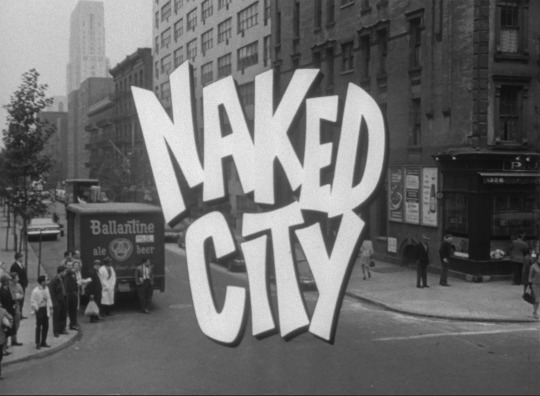

TV Noir on the Big Screen
The FNF will co-present Noir Television: Naked City with UCLA Film & Television Archive on Sunday, October 15, 7:00 p.m. at the Billy Wilder Theater located in Los Angeles' Hammer Museum.
The evening comprises two episodes of Naked City, a police drama from the original Golden Age of Television, and an in-person Q&A with FNF board member Alan K. Rode and actor/writer Michael McGreevey between screenings. Based on Jules Dassin's acclaimed 1948 motion picture of the same name, Naked City boasted location photography and a host of New York actors in thoughtful, original teleplays that emphasized character over action.
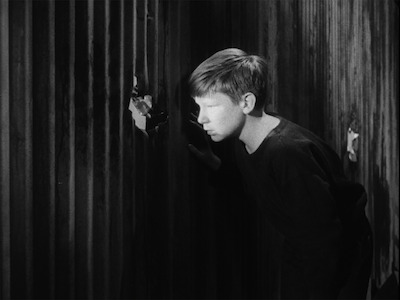

First, Jack Warden (Twelve Angry Men) guest stars as a fugitive who takes refuge in a tenement rooftop hideaway belonging to a troubled child (Mike McGreevey) in The King of Venus Will Take Care of You (1962). As the police close in, the misfit pair confront each other and their individual life circumstances, which are untenable.
A Horse Has a Big Head — Let Him Worry (1962) plays second. In groundbreaking casting, Diahann Carroll (Julia) guests as an earnest special education teacher searching for a sight-impaired student (John Megna) who, in defiant independence, wanders away on a field trip. Admission is free. Full details and program notes are available on UCLA's website.
#UCLA Film & TV Archive#tv noir#naked city#jack warden#Diahann Carroll#film noir#film noir foundation#alan k rode#mike mcgreevey
27 notes
·
View notes
Text
youtube
Watch the 2024 American Climate Leadership Awards for High School Students now: https://youtu.be/5C-bb9PoRLc
The recording is now available on ecoAmerica's YouTube channel for viewers to be inspired by student climate leaders! Join Aishah-Nyeta Brown & Jerome Foster II and be inspired by student climate leaders as we recognize the High School Student finalists. Watch now to find out which student received the $25,000 grand prize and top recognition!
#ACLA24#ACLA24HighSchoolStudents#youtube#youtube video#climate leaders#climate solutions#climate action#climate and environment#climate#climate change#climate and health#climate blog#climate justice#climate news#weather and climate#environmental news#environment#environmental awareness#environment and health#environmental#environmental issues#environmental education#environmental justice#environmental protection#environmental health#high school students#high school#youth#youth of america#school
16K notes
·
View notes